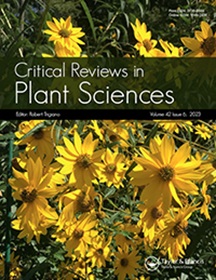球孢白僵菌(Beauveria bassiana)在植物界的定殖效率:meta分析
IF 6
2区 生物学
Q1 PLANT SCIENCES
引用次数: 1
摘要
摘要球孢白僵菌(Beauveria bassiana, Bb)是一种内生真菌,可在多种植物中定植。然而,该真菌在所有植物物种中的定殖多样性和定殖程度尚未得到全面总结。为了填补这一知识空白,对已发表的研究(2002-2018年)进行了一项荟萃分析,研究了球孢白球菌在植物界的定殖比例。我们收集了232篇已发表的论文,从中提取了1051项研究(个体治疗),并使用3版综合meta分析(CMA)软件进行了分析。确定了影响球孢白僵菌定殖的因素(n = 26)。在所有研究中,球孢白僵菌在不同植物类群中的平均内生定殖率为29%。球孢白僵菌在昆虫身上的定殖率最高。多数研究采用球孢白僵菌浓度为1 × 108分生孢子/ml;在1 × 1012个分生孢子/ml的施用量下,植物定植效果最好。在所有寄主植物中,定植率最高的是蚕豆、芸苔科植物、被子植物(一年生植物)、草本/草本/藤本生长习性植物和纤维根或丝状根植物。作为一种接种剂,球孢白僵菌最常在真叶发育后施用于整株。叶面喷雾接种是研究最多的接种方法,但在叶片上施用固体颗粒基质可获得较高的定植率。在受控环境下进行的研究结果表明,球孢白僵菌的内生定殖高于野外研究。球孢内生菌的存在主要是通过显微镜而不是分子方法证实的。不同研究间的高异质性(i2 = 97%)表明,内生球孢白僵菌在不同植物物种间的定殖存在很大差异。这些发现增加了我们对球孢白僵菌内生生活方式的理解和认识,有助于开发新的、可持续的、生态友好的球孢白僵菌疾病管理策略。本文章由计算机程序翻译,如有差异,请以英文原文为准。
Colonization Efficacy of the Endophytic Insect-Pathogenic Fungus, Beauveria bassiana, Across the Plant Kingdom: A Meta-Analysis
Abstract The insect-pathogenic fungus Beauveria bassiana (Bb) colonizes several plant species as an endophyte. However, the diversity of plants colonized and the extent of colonization by this fungus have not been summarized comprehensively across all plant species. To fill this knowledge gap, a meta-analysis of published studies (years 2002–2018) on the percentage of B. bassiana plant colonization across the plant kingdom was conducted. We collected 232 published papers from which 1,051 studies (individual treatments) were extracted and analyzed with Comprehensive Meta-Analysis, Version 3 (CMA) software. Factors (n = 26) influencing plant colonization by B. bassiana were identified. Across all studies, the mean endophytic colonization of B. bassiana was 29% in different plant taxa. Plant colonization by B. bassiana was highest for isolates collected from insects. Most studies applied B. bassiana at 1 × 108 conidia/ml; however, plant colonization was greatest with an application rate of 1 × 1012 conidia/ml. Among all plant hosts, colonization percentage was highest in faba bean, plants in the family Brassicaceae, angiosperms (eudicots, annuals), plants classified with a forb/herb/vine growth habit, and plants with fibrous or tap root systems. As an inoculant, B. bassiana was most frequently applied to the whole plant after true leaves had developed. The foliar spray was the most studied inoculation method, but the application of solid grain substrate to foliage gave higher plant colonization. Studies conducted in controlled environments resulted in higher endophytic colonization with B. bassiana than field studies. Endophytic B. bassiana presence was confirmed primarily with microscopy, rather than molecular methods. High heterogeneity (I 2 = 97%) across studies was identified with large variability in endophytic B. bassiana colonization across a diversity of plant species. These findings increase our understanding and knowledge of the endophytic lifestyle of B. bassiana, which will facilitate the development of novel, sustainable, and eco-friendly disease management strategies with B. bassiana.
求助全文
通过发布文献求助,成功后即可免费获取论文全文。
去求助
来源期刊
CiteScore
12.90
自引率
1.40%
发文量
15
审稿时长
>12 weeks
期刊介绍:
Critical Reviews in Plant Sciences focuses on presenting in-depth and up-to-date reviews of timely and/or cutting-edge subjects in the broad discipline of plant science, ranging from molecular biology/biochemistry through the areas of cell biology, plant pathology and physiology, genetics, classical botany, and ecology, to practical agricultural applications. Articles in the journal provide an up-to-date literature base for researchers and students, pointing the way towards future research needs. The journal is also a significant source of credible, objective information to aid decision makers at all levels.

 求助内容:
求助内容: 应助结果提醒方式:
应助结果提醒方式:


